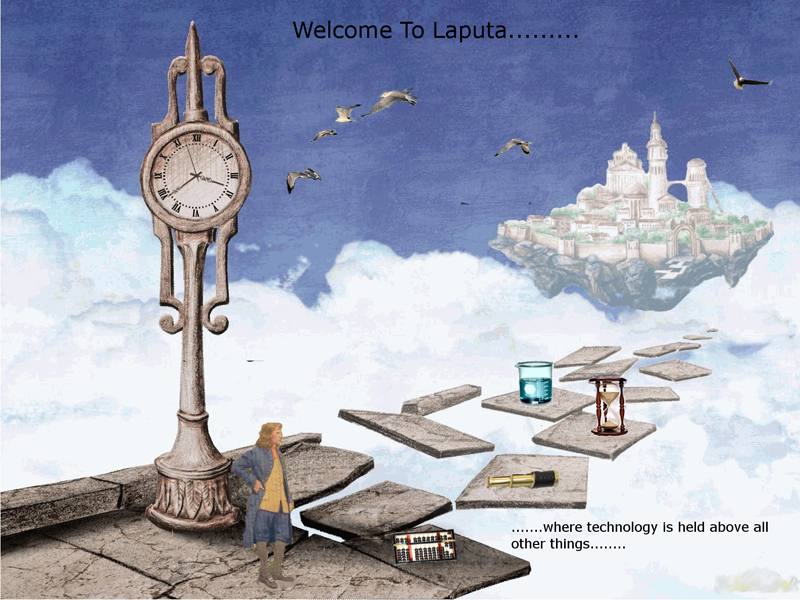

Laputa
In the third book of Gulliver’s Travels, Swift describes Gulliver’s travels in Laputa , a floating island. Gulliver presents the island as a peaceful place where each citizen displays a certain kindness to one another. As the story progresses, Laputa’s true colors begin to show. Initially perceived as a peaceful place, Laputa contains imperfections similar to other flawed societies. Laputa is a corrupt, persistent, and tyrannically ruled society. Swift’s central theme, Perception versus Reality, remains relevant in that the Laputans are viewed as a peaceful, violent-free society, yet is just as faulty as that of England.
In continuance with the imperfections of Laputa, Swift derives the word Laputa “from the Spanish ‘la puta’ which means the whore” (McNeil). According to Russell McNeil, this section of Gulliver’s Travels depicts people living in a place that deals unnaturally with their physical environment. Laputa itself has an adamantine base, which allows scientist to control the island’s movements using magnetic levitation. This ability alone is an unnatural use of physical nature; there are times when the king of Laputa orders the scientists to lower the island so that it may crush nearby cities (Laputa). The king does so if the neighboring cities rebel, form mutinies, or if they refused to pay tribute to his majesty (Swift 158). Additionally, this action taken by the king parallels the many actions taken by the Whig government of eighteenth-century England. The islanders appear to be genuinly congenial, but in truth it is just an example of one of the many ways one’s perception can cloud reality.
Laputa also threatens to cover rebel regions with their shadow, blocking sunlight, rain, and many other necessities of nature. Many of the Laputans view themselves as intelligent simply because they wear a device known as a flapper. This device supposedly helps the citizens complete everyday tasks – tasks that normal humans could complete without much thought. Experiments carried out by the citizens appear insightful, but with careful scrutiny it becomes apparent that these experiments are ridiculous and pointless. Turning fecal matter back into food does not demonstrate intelligence. Again, the readers’ and Gulliver’s perception of the Laputans clouds their vision to initially see the reality of the situation.
As exemplified by the Laputans, it is apparent that the divide between perception and reality can be quite vast. Laputa is first viewed as a peaceful, solemn civilization; with a deeper analysis, Laputa transforms into a corrupt society that defines intelligence in menial ways. The king’s actions display his wickedness towards the neighboring cities. Also, due to the ridiculous experiments and the quizzical displays of “intelligence,” it is apparent that Laputa has the false illusion of place of high stature. This perception clouds the reality of how the city operates.
Julian Varo's interpretation of Laputa in
his travel poster
(Click poster for a larger image)
-----------------------------------------------
<--Back to home
Get a Plot Summary
View Concept Map
As exemplified by the Laputans, it is apparent that the divide between perception and reality can be quite vast. Laputa is first viewed as a peaceful, solemn civilization; with a deeper analysis, Laputa transforms into a corrupt society that defines intelligence in menial ways. The king’s actions display his wickedness towards the neighboring cities. Also, due to the ridiculous experiments and the quizzical displays of “intelligence,” it is apparent that Laputa has the false illusion of place of high stature. This perception clouds the reality of how the city operates.

